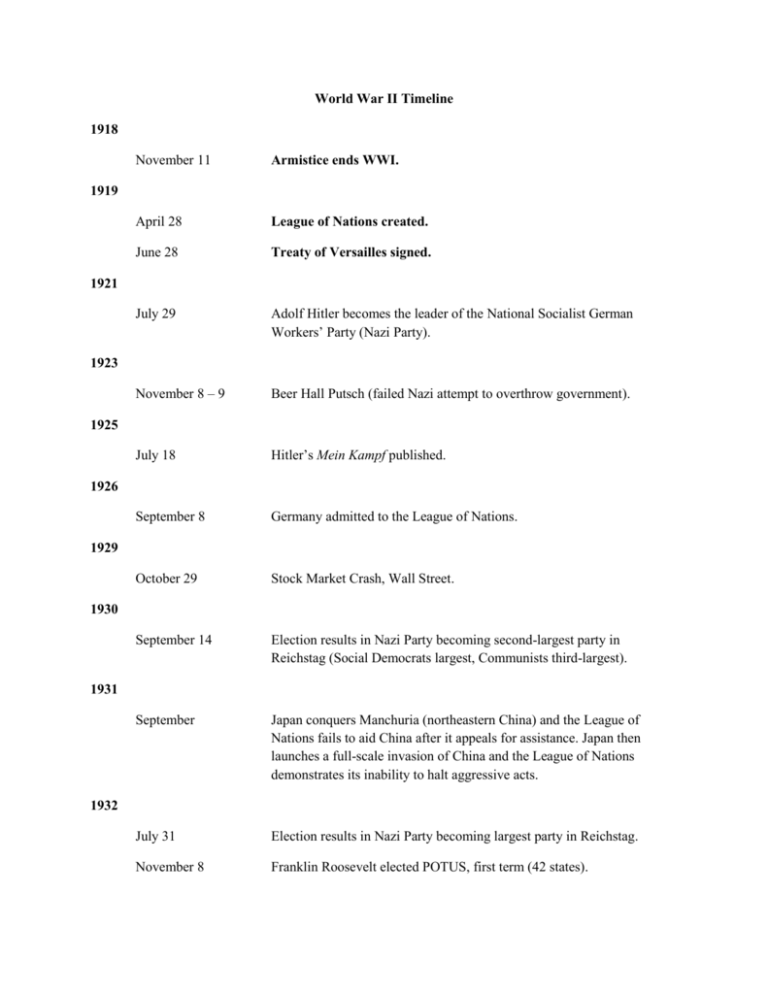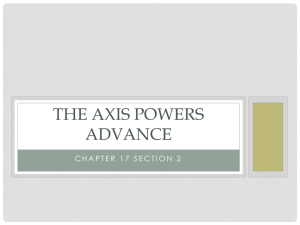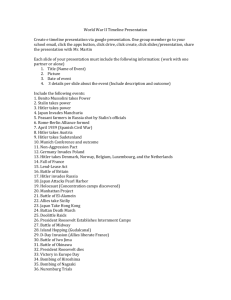EH Chapter 27 WWII Timeline
advertisement

World War II Timeline 1918 November 11 Armistice ends WWI. April 28 League of Nations created. June 28 Treaty of Versailles signed. July 29 Adolf Hitler becomes the leader of the National Socialist German Workers’ Party (Nazi Party). November 8 – 9 Beer Hall Putsch (failed Nazi attempt to overthrow government). July 18 Hitler’s Mein Kampf published. September 8 Germany admitted to the League of Nations. October 29 Stock Market Crash, Wall Street. September 14 Election results in Nazi Party becoming second-largest party in Reichstag (Social Democrats largest, Communists third-largest). September Japan conquers Manchuria (northeastern China) and the League of Nations fails to aid China after it appeals for assistance. Japan then launches a full-scale invasion of China and the League of Nations demonstrates its inability to halt aggressive acts. July 31 Election results in Nazi Party becoming largest party in Reichstag. November 8 Franklin Roosevelt elected POTUS, first term (42 states). 1919 1921 1923 1925 1926 1929 1930 1931 1932 1933 January 30 Hitler becomes Chancellor of Germany. February 27 Reichstag fire blamed on the Communists. March First concentration camp established at Dachau to hold Social Democrats and Communists; concentration camp at Oranienburg established to hold homosexuals. March 23 Reichstag passes the Enabling Act giving Hitler the power to rule by decree (dictatorial power). April 1 Nazi boycott of Jewish owned stores. April 6 German Student Union calls for nationwide “literary purge” of unGerman books. April 26 The Gestapo, a secret police force in Nazi Germany, is formed by Hermann Goring. May 10 Nationwide book burning ceremonies. October 14 Germany leaves the League of Nations. April 24 The Gestapo becomes part of the SS led by Heinrich Himmler. July 25 Nazis murder Austrian Chancellor Dollfuss in attempted coup d’état to control Austria. August 2 German President Paul von Hindenburg dies. August 19 Hitler becomes Fuhrer of Germany. October Major arrest of homosexuals throughout Germany. March 16 Hitler violates Treaty of Versailles by introducing military draft and beginning the construction of a new air force, the Luftwaffe. April Major arrest of Jehovah Witnesses throughout Germany. June 18 Anglo-German Naval Treaty limits German navy to 35% of British navy, which formally disregards the Treaty of Versailles. September 15 Nuremberg Laws passed restricting the civil liberties of German Jews. 1934 1935 1936 March 7 Hitler violates the Treaty of Versailles by sending German troops to occupy the Rhineland. Great Britain and France do nothing in response. May 9 Italian forces under Mussolini take control of Ethiopia and the League of Nations further demonstrates its inability to halt aggressive acts. July 17 Spanish Civil War begins between republican Popular Front (supported by Soviet Union) and authoritarian Nationalists (supported by Germany and Italy). August 1 Summer Olympics held in Berlin. October 1 General Francisco Franco and Nationalists come to power in Spain. November 3 Roosevelt re-elected POTUS, second term (46 states). November 25 Anti-Comintern Pact signed by Germany and Japan, which formed an alliance against communism and the Comintern (Third International). June 11 Joseph Stalin begins purge of Red Army generals. July 16 Concentration camp at Buchenwald established. November 6 Italy joins the Anti-Comintern Pact, which forms the Rome-BerlinTokyo Axis. 1937 Hitler outlines the imperialistic war plans of Germany at the Hossbach Conference. December 13 Rape of Nanjing begins; 300,000 Chinese civilians are killed by Japan. March 12 – 13 Anschluss (Annexation) of Austria by Germany. Great Britain and France do nothing in response. April Sudeten German Party (pro-Nazi) begins to demand autonomy for Sudetenland, a German-speaking region of Czechoslovakia. September 12 Hitler demands the right of self-determination for the Sudeten Germans and threatens military intervention. Sudeten Germans call for German annexation of Sudetenland. September 30 Munich Conference: British Prime Minister Neville Chamberlain appeases Hitler on his desire for the Sudetenland in Czechoslovakia. 1938 October 15 German troops occupy the Sudetenland. November 9 – 10 Kristallnacht, or “Night of Shattered Glass” destroys Jewish stores. January 30 Hitler publicly announces his desire to eradicate the Jewish population of Europe in speech to the Reichstag. March 15 – 16 German troops occupy the rest of Czechoslovakia. March 28 Franco and the Nationalists take control of Madrid; the Spanish Civil War comes to an end. May 22 Germany and Italy form military alliance by signing Pact of Steel. June Jewish refugees aboard the M.S. St. Louis denied entry into the United States and return to Europe. August 23 Germany and Soviet Union sign Non-aggression Pact, which included a pledge of neutrality from the Stalin if Hitler invaded Poland. August 25 Great Britain and Poland sign the Anglo-Polish Agreement, which establishes a defensive alliance. September 1 Germany invades Poland. The Germans demonstrate the effectiveness of their Blitzkrieg (lightning war) technique, which involves the use of air power and tanks as support for fast-moving infantry. September 3 Great Britain, France, Australia, and New Zealand declare war on Germany. 1939 Battle of the Atlantic begins (longest battle of WWII). British and Canadian navies fought German navy for control of the seas. September 4 Royal Air Force (RAF) attacks the German navy. September 5 United States declares neutrality. September 10 Canada declares war on Germany. September 17 Soviet Union invades Poland. September 28 Germany and Soviet Union divide Poland between themselves. October Euthanasia program authorized within Germany to kill the institutionalized mentally and physically disabled. November 8 Assassination attempt on Hitler fails. November 30 Soviet Union invades Finland; referred to as the “Winter War.” December 14 Soviet Union expelled from League of Nations. The “Phony War” of the winter of 1939-1940 involved no fighting between Germany and France or Great Britain. The French reinforced the Maginot Line, a line of fortifications, to defend France. 1940 March 12 Finland signs peace treaty with Soviet Union ceding territory. April 9 Germany invades Denmark and Norway. April 27 Himmler orders the establishment of Auschwitz concentration camp. May 10 Germany invades France, Belgium, and Holland. Winston Churchill becomes Prime Minister of Great Britain. May 15 Holland surrenders to Germany. May 27 Evacuation of Allied troops from Dunkirk at the Belgian-French border begins. May 28 Belgium surrenders to Germany. June 4 Evacuation of Allied troops from Dunkirk completed. Over 300,000 soldiers were successfully transported across the English Channel to Great Britain. June 10 Norway surrenders to Germany. Italy declares war on France and Great Britain. June 14 Germans occupy Paris. June 18 Hitler and Mussolini meet in Munich to discuss the war effort. Soviet Union occupies the Baltics (Estonia, Latvia, Lithuania). French Prime Minister Henri Petain (WWI hero) begins negotiations with Germany to sign an armistice; Charles de Gaulle proclaims the Free French Forces as a French-government in exile in London. June 22 Petain signs armistice with Germany; the French government remained in control only in southern France and was called the Vichy government. July 10 Great Britain stands alone against Germany as the Battle of Britain begins. July 23 Soviet Union annexes the Baltics (Lithuania, Latvia, and Estonia). August 3 Italy takes control of British Somaliland (Somalia). August 19 Italy takes control of British East Africa (Kenya). August 23 – 24 German air raids on London. August 25 – 26 British air raids on Berlin. September 3 Hitler plans Operation Sea Lion (invasion of Great Britain). September 13 Italy invades Egypt. September 16 U.S. Congress passes military draft. September 27 Axis Pact signed by Germany, Italy, and Japan. October 3 Anti-Jewish legislation passed by Vichy France. October 7 Germany occupies Hungary and Romania. October 12 Hitler postpones Operation Sea Lion until spring 1941 due to the failure of the Battle of Britain. Establishment of Warsaw Ghetto in Poland to hold Jewish population. October 28 Italy invades Greece. November 5 Roosevelt re-elected POTUS, third term (38 states). November 20 Hungary joins Axis Powers. November 23 Romania joins Axis Powers. December 9 – 10 British offensive against Italy in North Africa. January 22 British take control of Tobruk, Libya (port city). February 14 German “Africa Korps” commanded by Erwin Rommel (Desert Fox) arrive in Libya to begin an offensive against the British. March 11 Roosevelt signs the Lend-Lease Act, which provided war materials to Great Britain, the Soviet Union, and the Republic of China. March 27 Pro-Axis government overthrown in Yugoslavia. April 3 Pro-Axis government established in Iraq. April 6 Germany invades Greece and Yugoslavia. 1941 April 17 Yugoslavia surrenders to Germany. April 27 Greece surrenders to Germany. May 15 Operation Brevity, British counter-offensive in Egypt begins. June 4 Pro-Allied government established in Iraq. June 8 Allies invade Syria and Lebanon. June 22 Operation Barbarossa, German offensive against Soviet Union in violation of Non-aggression Pact. Three fronts: North (Leningrad), Central (Moscow), and Southern (Ukraine). July 26 Roosevelt freezes Japanese assets in United States and suspends diplomatic relations. August 1 United States announces an oil embargo against Axis powers. August 14 Roosevelt and Churchill announce the Atlantic Charter, a declaration of economic, political, and diplomatic principles to guide the post-war world. September Euthanasia program in Germany ended; over 70,000 people were killed. September 29 – 30 33,000 Jews murdered in Kiev, Ukraine. October First deportation of German and Austrian Jews to ghettos in Eastern Europe. October 2 Operation Typhoon, German offensive against Moscow. December 5 – 6 Operation Typhoon abandoned. Soviet Union begins major counteroffensive. December 7 Japan bombs U.S. naval station in Pearl Harbor, Hawaii and attacks European colonial territories in Southeast Asia. December 8 United States and Great Britain declare war on Japan. December 11 Germany declares war on United States. January 1 Declaration of the United Nations signed by 26 Allied nations requiring the “unconditional surrender” of the Axis Powers and affirming the ideals of self-determination promoted by Wilson after WWI. January 13 German submarine offensive begins along eastern coast of U.S. 1942 January 20 Wannsee Conference in Berlin to plan and coordinate Final Solution. January 26 American troops begin to arrive in Great Britain. May 4 – 8 Battle of Coral Sea, U.S. halts Japan’s naval expansion in Pacific. May 26 Battle of Gazala, Rommel begins offensive to take control of Tobruk, Libya (port city). June 4 – 7 Battle of Midway Island, U.S. navy takes control of Pacific. June 21 Germany takes control of Tobruk, Libya (port city). July 1 – 30 First Battle of El Alamein (Egypt), successful Allied offensive. July 22 Treblinka extermination camp completed; 870,000 Jews were murdered by August of the next year. August 7 British General Montgomery takes command of Allied forces in North Africa. September 12 Battle of Stalingrad: German offensive. November 8 Operation Torch, American invasion of Morocco and Algeria led by General Dwight Eisenhower. December 31 Battle of Barents Sea, British naval victory against Germany. January 10 Battle of Stalingrad: Soviet Union launches counter-offensive. January 14 – 24 Casablanca Conference: Roosevelt and Churchill reaffirm that Germany must offer an “unconditional surrender” for fighting to cease. They plan to invade both Italy and France. February 2 German troops surrender at Stalingrad. April 19 Warsaw Ghetto Uprising; largest Jewish revolt against the Nazis. May Allies victorious in North Africa. American troops led by Eisenhower from the west and British troops led by Montgomery in the east take control of Tunisia where the Axis powers surrender. July 19 Allies bomb Rome. July 21 Himmler orders the liquidation of all ghettos in Poland and USSR. July 25 – 26 Italian Resistance overthrows Mussolini. September Germany occupies Rome and re-establish Mussolini’s government. 1943 October 1 Allies enter Italy. October 2 Nazis attempt to deport Danish Jews, but Danish people use boats to smuggle over 7,000 Danish Jews to neutral Sweden. The Danes were the only Europeans to carry out a coordinated national effort to save their Jewish population. November 28 Tehran Conference: Roosevelt, Churchill, and Stalin (Big Three) meet in Tehran, Iran to discuss the war effort. Roosevelt and Stalin support an invasion of France, while Churchill supports an invasion of the Balkans. They agree to a post-war partition of Germany, and Stalin made clear his intentions to extend Soviet influence in Eastern Europe following the war. April 8 Soviet counter-offensive in Crimea. May 12 Germany surrenders in Crimea. June 5 Allies enter Rome. June 6 Operation Overlord (D-Day), Allied invasion of France at Normandy. June 22 Operation Bagration, Soviet counter-offensive in Ukraine and Poland. July 20 Assassination attempt on Hitler fails. August 15 Operation Dragoon, Allied invasion of France of Marseilles. August 19 – 20 Soviet Union counter-offensive in the Balkans. August 25 French and American troops liberate Paris. September 17 Operation Market Garden, Allied bombing of Holland. October 7 Prisoners blow up one of the gas chambers at Auschwitz. October 14 Rommel commits suicide. December 4 Civil war erupts in Greece. December 26 – 27 Battle of the Bulge, unsuccessful German offensive in Belgium. January 27 Soviet troops liberate Auschwitz. February 4 – 11 Yalta Conference: Big Three meet to discuss the war effort. Stalin agrees to enter the war against Japan in exchange for a Soviet sphere of 1944 1945 influence in East Asia. France is added as the fourth occupier of a postwar Germany. Voting procedures for the Security Council of the new United Nations and the future of Poland are discussed, as well. February 13 – 15 Allies bomb Dresden. March Allied forces, both American and Soviet, begin pouring into Germany. April 11 American troops liberate Buchenwald. April 12 Roosevelt dies of a stroke in Georgia. April 13 Soviet troops occupy Vienna. April 28 Mussolini shot and killed by the Italian Resistance. April 29 American troops liberate Dachau. April 30 Hitler commits suicide in Berlin May 7 Germany surrenders to the Allies. July 17 Potsdam Conference: Truman, Churchill, and Stalin meet to discuss post-war plans. The meeting lasted until August 2 and Clement Atlee, leader of the Labour Party, replaced Churchill as Prime Minister. Relations between the U.S. and Soviet Union begin to deteriorate. August 6 – 9 U.S. drops atomic bombs on Hiroshima and Nagasaki. August 14 Japan surrenders to the Allies. November 20 Nuremberg War Crimes Trials begin.








